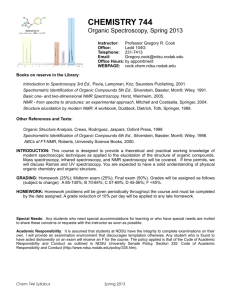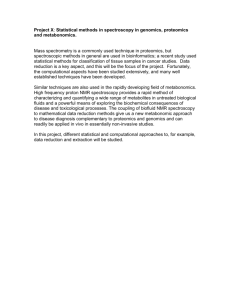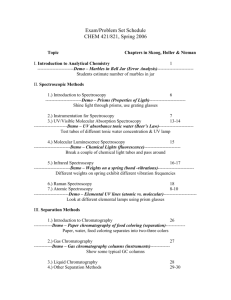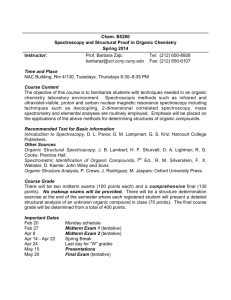CHEM 7310 - chem.usu.edu
advertisement
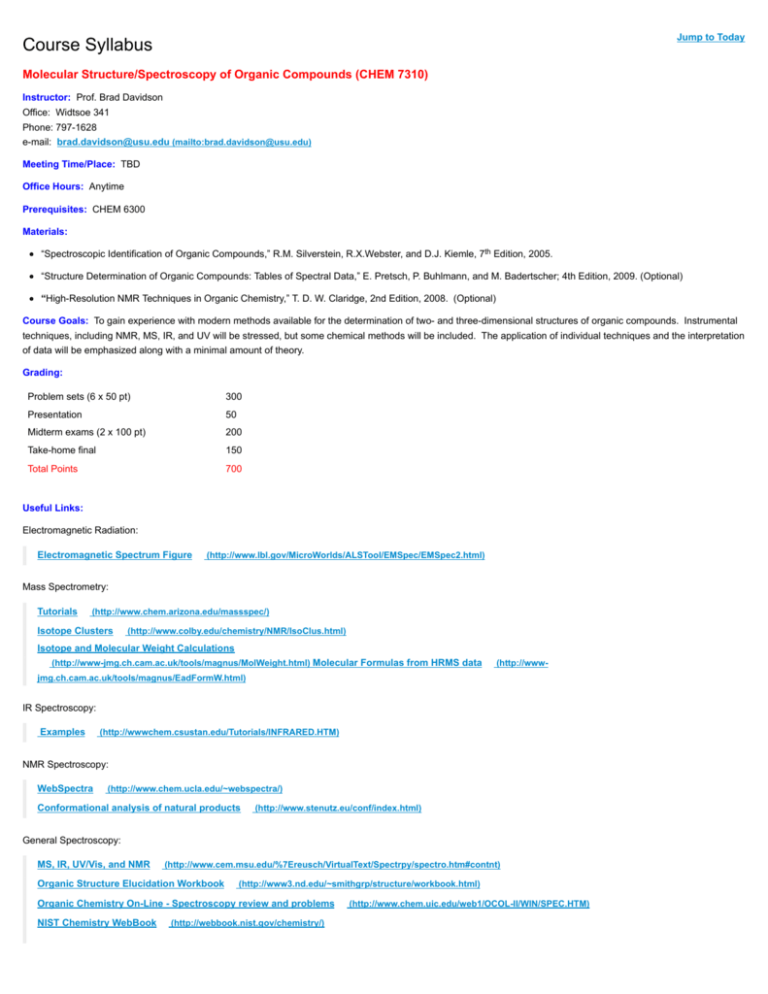
Jump to Today Course Syllabus Molecular Structure/Spectroscopy of Organic Compounds (CHEM 7310) Instructor: Prof. Brad Davidson Office: Widtsoe 341 Phone: 797-1628 e-mail: brad.davidson@usu.edu (mailto:brad.davidson@usu.edu) Meeting Time/Place: TBD Office Hours: Anytime Prerequisites: CHEM 6300 Materials: “Spectroscopic Identification of Organic Compounds,” R.M. Silverstein, R.X.Webster, and D.J. Kiemle, 7th Edition, 2005. “Structure Determination of Organic Compounds: Tables of Spectral Data,” E. Pretsch, P. Buhlmann, and M. Badertscher; 4th Edition, 2009. (Optional) “High-Resolution NMR Techniques in Organic Chemistry,” T. D. W. Claridge, 2nd Edition, 2008. (Optional) Course Goals: To gain experience with modern methods available for the determination of two- and three-dimensional structures of organic compounds. Instrumental techniques, including NMR, MS, IR, and UV will be stressed, but some chemical methods will be included. The application of individual techniques and the interpretation of data will be emphasized along with a minimal amount of theory. Grading: Problem sets (6 x 50 pt) 300 Presentation 50 Midterm exams (2 x 100 pt) 200 Take-home final 150 Total Points 700 Useful Links: Electromagnetic Radiation: Electromagnetic Spectrum Figure (http://www.lbl.gov/MicroWorlds/ALSTool/EMSpec/EMSpec2.html) Mass Spectrometry: Tutorials (http://www.chem.arizona.edu/massspec/) Isotope Clusters (http://www.colby.edu/chemistry/NMR/IsoClus.html) Isotope and Molecular Weight Calculations (http://www-jmg.ch.cam.ac.uk/tools/magnus/MolWeight.html) Molecular Formulas from HRMS data (http://www- jmg.ch.cam.ac.uk/tools/magnus/EadFormW.html) IR Spectroscopy: Examples (http://wwwchem.csustan.edu/Tutorials/INFRARED.HTM) NMR Spectroscopy: WebSpectra (http://www.chem.ucla.edu/~webspectra/) Conformational analysis of natural products (http://www.stenutz.eu/conf/index.html) General Spectroscopy: MS, IR, UV/Vis, and NMR (http://www.cem.msu.edu/%7Ereusch/VirtualText/Spectrpy/spectro.htm#contnt) Organic Structure Elucidation Workbook (http://www3.nd.edu/~smithgrp/structure/workbook.html) Organic Chemistry On-Line - Spectroscopy review and problems NIST Chemistry WebBook (http://webbook.nist.gov/chemistry/) (http://www.chem.uic.edu/web1/OCOL-II/WIN/SPEC.HTM) Database of NMR spectra (http://www.nmrdb.org) Comments: To become proficient in interpreting spectroscopic data, practice is essential. Organic molecules may include an almost infinite combination of functional groups, only a few of which can be reviewed during this course. Therefore, you will be required to use your imagination and logic to piece together data in attempt to deduce the structures of molecules that are unlike those you have previously seen. Teamwork and the use of data tables and textbooks are permissible on problem sets, but the primary literature is off limits. Final answers to be turned in must be written up individually. Problem sets will be due at the beginning of class one week after they have been handed out. Mid-term exams will be scheduled for 3 hr during an non-class time, when all are available. They will be open book. The final exam will be take-home, and must be worked independently, using any resource other than the primary literature. During the last week of the semester, each student will give a 15-20 min presentation on a topic of their choice that is relevant to the course material. Topics should be discussed with the instructor at least 2 weeks in advance. Reasonable accommodation will be provided for all persons with disabilities in order to insure equal participation with the program. Information concerning dropping classes, academic honesty/honor code, and other academic policies is available in the Schedule of Classes. Proposed Schedule Week Dates Subject 1 9/26-9/29 Introduction; pre-test; classical structure determination Reading 1D NMR Spectroscopy – Proton Theory Chemical shift 2-3 9/1-9/12 Spin coupling Chapt 3 Chemical shift equivalence Nuclear Overhauser effect 1D NMR Spectroscopy – Carbon Theory 4-5 9/15-9/26 Spin Coupling Chemical Shift Chapt 4 DEPT IR Spectroscopy 6 9/29-10/3 Theory Chapt 1 Functional group absorptions UV/Vis Spectroscopy Theory 7 10/6-10/10 Lambert-Beer law Handout lambda max predictions Exam 1 (date and time TBD) Mass spectrometry Theory – ionization techniques 8-9 10/13-10/24 – mass analyzers Chapt 1 Interpretation – molecular ion – fragmentation Advanced NMR – Correlation Spectroscopy Theory – rotating frame – pulse sequences 10-11 10/27-11/7 – experimental considerations Chapt 5 Homonuclear Heteronuclear Applications/examples Exam 2 (date and time TBD) 12 11/10-11/14 NMR of Other Nuclei Stereochemistry Chapt 6 Relative – J-coupling 13-14 11/17-11/25 – nuclear Overhauser effect Absolute – NMR methods – optical methods 15 16 Date 12/1-12/5 Problems; presentations FINAL (Take-home; pick-up 12/5, due 12/10, 5:00 PM Details Handouts
